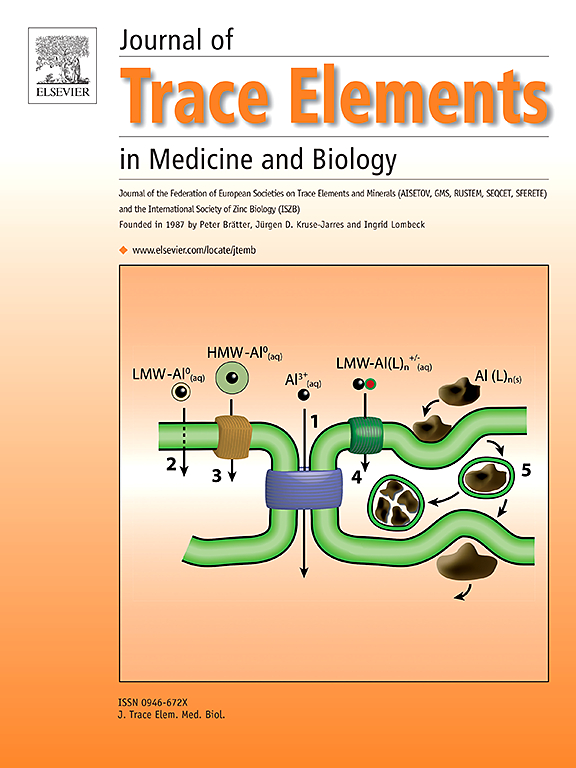Dietary manganese requirement of Cirrhinus mrigala juveniles
IF 3.6
3区 医学
Q2 BIOCHEMISTRY & MOLECULAR BIOLOGY
Journal of Trace Elements in Medicine and Biology
Pub Date : 2025-03-29
DOI:10.1016/j.jtemb.2025.127639
引用次数: 0
Abstract
This experiment determined the Mn requirement of Cirrhinus mrigala and evaluated its effects on growth indices and health status. Six experimental diets were prepared containing 0, 5, 10, 15, 20 and 25 mg/kg Mn from MnSO4·H2O and analyzed Mn contents were 1.48, 6.37, 11.24, 16.35, 20.8 and 26.15 mg/kg, respectively. A total of 270 C. mrigala juveniles (average initial weight 12.784 ± 0.613 g) were acclimatized and distributed to eighteen aquaria (70 L capacity and 15 fish/aquarium). Each experimental diet was fed in triplicate up to satiation for 60 days. After completion of trial, growth performance and feed intake increased with increasing Mn concentrations in diets up to 26.15 mg/kg. However, feed conversion ratio (FCR) decreased with increasing Mn concentration up to 16.35 mg/kg. Furthermore, whole-body proximate composition improved with increasing Mn concentrations up to 16.35 mg/kg. Mn content in vertebrae, whole body, muscles, kidney and scales significantly increased with increments in Mn concentrations in the diet, however, Mn absorption reached at saturation at 16.35 mg/kg. Hepatic alkaline phosphatase and antioxidant enzymes activities increased significantly with increasing Mn concentrations up to16.35 mg/kg in the diet, while opposite trend was observed in thiobarbituric acid reactive substances (TBARS) content. Based on weight gain%, FCR, Mn content in vertebrae and TBARS content, dietary Mn requirements of the C. mrigala juveniles were assessed to be 13.18, 16.35, 17.22 and 16.45 mg/kg, respectively. In conclusion, C. mrigala require 13.18–17.22 mg/kg Mn in diet for optimum growth performance and health status.
猕猴幼鱼日粮锰的需要量
本实验测定了大菱鲆对锰的需求量,并评估了锰对其生长指数和健康状况的影响。从 MnSO4-H2O 中制备了六种含锰量分别为 0、5、10、15、20 和 25 mg/kg 的实验日粮,分析锰含量分别为 1.48、6.37、11.24、16.35、20.8 和 26.15 mg/kg。总共有 270 尾克里加拉鱼幼鱼(平均初始体重为 12.784 ± 0.613 克)经过适应性训练后被分配到 18 个水族箱(容量为 70 升,每个水族箱 15 尾鱼)中。每种试验饲料一式三份,喂养 60 天直至饱食。试验结束后,随着日粮中锰浓度的增加,生长性能和饲料摄入量均有所提高,最高达 26.15 毫克/千克。然而,饲料转化率(FCR)随着锰浓度的增加而降低,最高为 16.35 毫克/千克。此外,随着锰浓度(最高为 16.35 毫克/千克)的增加,全身近似组成也有所改善。脊椎骨、全身、肌肉、肾脏和鳞片中的锰含量随着日粮中锰浓度的增加而显著增加,但锰的吸收在 16.35 毫克/千克时达到饱和。随着日粮中锰浓度的增加,肝脏碱性磷酸酶和抗氧化酶活性显著增加,最高达 16.35 毫克/千克,而硫代巴比妥酸活性物质(TBARS)含量则呈相反趋势。根据增重率、饲料报酬率、椎骨中的锰含量和 TBARS 含量,评估出海鲈幼鱼对日粮锰的需求量分别为 13.18、16.35、17.22 和 16.45 毫克/千克。总之,为了获得最佳的生长性能和健康状况,克里加拉鱼的日粮需要 13.18-17.22 毫克/千克的锰。
本文章由计算机程序翻译,如有差异,请以英文原文为准。
求助全文
约1分钟内获得全文
求助全文
来源期刊
CiteScore
6.60
自引率
2.90%
发文量
202
审稿时长
85 days
期刊介绍:
The journal provides the reader with a thorough description of theoretical and applied aspects of trace elements in medicine and biology and is devoted to the advancement of scientific knowledge about trace elements and trace element species. Trace elements play essential roles in the maintenance of physiological processes. During the last decades there has been a great deal of scientific investigation about the function and binding of trace elements. The Journal of Trace Elements in Medicine and Biology focuses on the description and dissemination of scientific results concerning the role of trace elements with respect to their mode of action in health and disease and nutritional importance. Progress in the knowledge of the biological role of trace elements depends, however, on advances in trace elements chemistry. Thus the Journal of Trace Elements in Medicine and Biology will include only those papers that base their results on proven analytical methods.
Also, we only publish those articles in which the quality assurance regarding the execution of experiments and achievement of results is guaranteed.

 求助内容:
求助内容: 应助结果提醒方式:
应助结果提醒方式:


